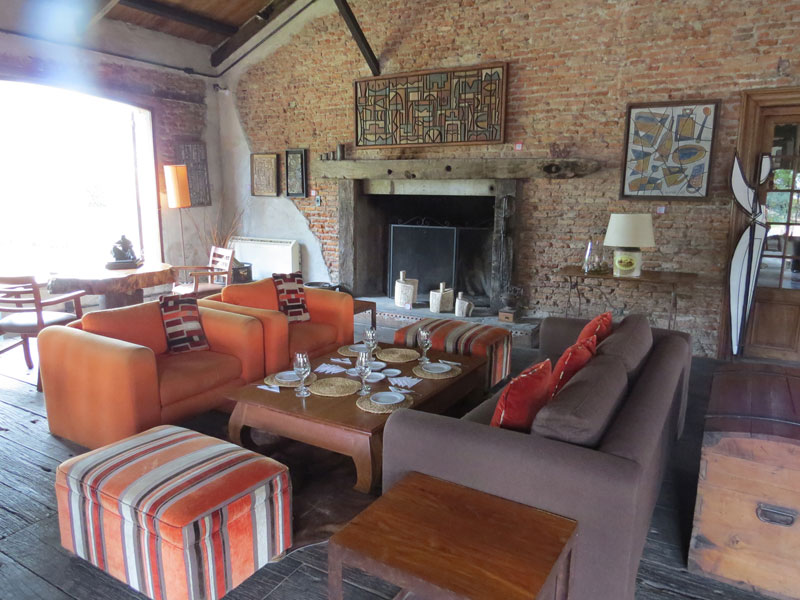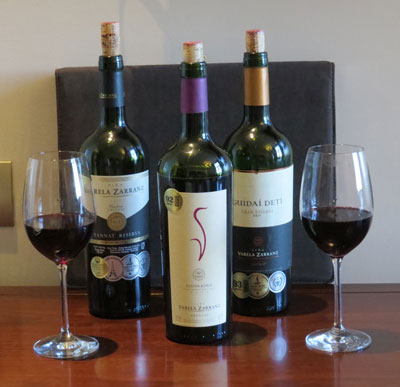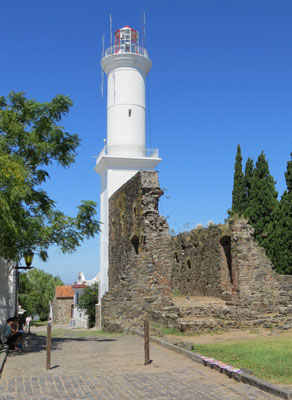Savoring a taste of Uruguay’s acclaimed wine region
This article appears on page 40 of the January 2016 issue.
Visiting wine regions is a hobby of ours, not only for the wine but because vineyards tend to occupy some of the world’s most beautiful places. As Californians, we also appreciate the nexus between the grapes grown in our state and the same grapes grown in their country of origin.
Some of South America’s best vineyards and wineries lie between 32°53'S and 34°51'S in latitude. Within that narrow band (a width of about 119 miles) are Uruguay’s rising wine region, Argentina’s famous malbec vineyards in the Mendoza region and Chile’s Casablanca and San Antonio valleys.
We wanted to visit Uruguay, since it was the only South American country we had not been to, but a trip solely to Uruguay didn’t seem to justify the travel cost or the flight time. A little research, a good map and a trusted travel agency sent us off to more of South America’s little-visited wine country.
While this article will focus on undiscovered Uruguay, our adventure included Mendoza, Argentina, and Chile’s central wine regions.
Making arrangements
Jennie is the “travel arranger” in our family, so she mapped out the route we wanted as well as an itinerary that would take us from Uruguay to Argentina and then Chile. She contacted Amazing Peru (800/704-2915, www.amazingperu.com), a travel company headquartered in Lima that we had used for a trip to Venezuela and the Guianas and with which we had been extremely pleased.
Agent Jim Turner, communicating with us by email, made all of our land arrangements. The total tour cost for the two of us was $15,400, which included 19 winery visits and tastings, all breakfasts, local guides and drivers, nine gourmet meals, five nights' accommodation in Uruguay and four nights in Argentina and all airport and ferry transfers. We booked three nights’ accommodation in Chile and international flights separately.
Off we went on our South American wine and vineyard adventure, or, as we came to affectionately call it, our “Gluttony & Sloth Tour”!
Montevideo
We flew American Airlines from Los Angeles to Montevideo, Uruguay, via Miami. Montevideo has one of the most efficient Immigration processes we have experienced. Once a plane arrives, almost every Immigration kiosk opens and a flash board lists the number of the kiosk for the next passenger in line, making for a very quick entry into the country.
When we arrived at the baggage carousel, our luggage was already out. We had deplaned, passed through Immigration and retrieved our luggage in less than 30 minutes!
Our guide and driver met us as we exited Customs, and we were driven to our hotel, the Sofitel Montevideo Casino on the Rambla Republica de Mexico. Opened in 1921, it has been refurbished to its original splendor, and it was truly elegant.
The Rambla Republica de Mexico is a very impressive, wide promenade that runs for miles between the beach, the highway and the town. A drive along it felt more like we were in a resort town than in the capital of a South American country.
A visit to the historic Mercado del Puerto, a huge enclosed market near the port, was a sensory delight. Open-grill barbecues were cooking sausage, chicken and beef, enticing customers into their restaurants and eating stalls.
We ate at one of the many full-serve restaurants and ordered a “standard” grilled chicken, which turned out to be anything but standard. It was a feast that cost us relatively few Uruguayan pesos. Bread, pesto dip, sautéed onions and peppers with sausage, French fries and a quarter of a chicken plus a salad set us back the equivalent of a whopping $5 each!
The grapes
Wine is an important part of the culture of Uruguay.
The country’s major grape, tannat, is little known in the United States. Originally from France, it was taken to Uruguay in the late 19th century. The varietal had become nearly extinct in France due to the ravages of the plant louse phylloxera, but in Uruguay it thrived.
It is a big-bodied red wine that, at its worst, is highly tannic but at its best is a refined competitor with the world’s great red wines.
Wine tasting in Uruguay was an experience unlike any we have had. Perhaps because it is an emerging region or perhaps because there are not many tourists, compared with the numbers in other wine grape-growing countries, or maybe due to the innate Uruguayan hospitality — whatever the reason — it is an experience not to be missed.
A typical tasting consisted of several generous pours of different vintages and blends of tannat as well as a white wine such as Albariño or chardonnay. We were very careful once we realized that a “pour” was not a California-measured amount but a quarter to a third of a glass of wine.
The tastings also usually included an appetizer platter of bread, olive oil, cheese and cold cuts and might even feature cheese pies and ice cream sundaes with wine sauce.
The wineries
Our first winery and vineyard visits were just outside Montevideo, itself. The Juanicó Winery had wonderful historic buildings, with the main structure dating from 1830.
After a tour of the grounds, we tasted their wines with appetizers and enjoyed watching the tero-tero (southern lapwing) and horneros birds that were numerous in the vineyards and grassy areas.
Our next winery was Vinos Finos H. Stagnari, perhaps Uruguay’s best known. It has earned the most awards for its tannats, not only in Uruguay but internationally.
We tasted numerous wines, again with appetizer plates. The highlight was the award-winning 2012 Tannat Viejo from their Salto vineyards.
After our first day’s tasting experiences, our guide took us on a tour of historic Montevideo. The National Congress Building, the 1804 cathedral, sculptures representing the 1811 revolution, and the historic downtown, with portions of the old city wall intact, were only a few of the sights not to be missed.
Our next day’s adventure took us to the Canelones wine region. Passing fields of pampas grass, orchards and vineyards, we visited Bodega Bouza, where we had an included lunch with our wine pairings. The experience was wonderful.
All aspects of Bouza’s wine operation are accomplished by hand, from the picking to the processing.
An outstanding experience
One of our favorite experiences in Uruguay took place at our next stop, Viña Varela Zarranz, a multigenerational family-operated winery with beautiful grounds. We took a tour of their cellars and their huge, old oak tanks (16,900 liters each!).
We had an outdoor tasting hosted by family member Victoria Zarranz and her fiancé, Alejo, and were served a very large appetizer plate, two large pieces of cheese pie and numerous pours of their wine.
While not yet exported to the US, their wines are not to be missed by those traveling to Uruguay’s wine country. All were excellent.
Just when we thought we might burst from the sheer volume of food accompanying the wine, out came an ice cream sundae dessert with a tannat sauce poured over the top paired with a glass of late-harvest chardonnay. Incredible!
We spent time discussing the complexities of different wines, the difficulties and costs of exporting to the US and the current lack of infrastructure to support travelers’ visits to wineries. After several hours with this wonderful, knowledgeable couple, we returned to Montevideo.
Historic Colonia
The next morning we left Uruguay’s capital and drove to Colonia del Sacramento, passing fields of cultivated farmland. The city is best visited on foot, although care must be taken because the historic streets are made of rock and cobblestones that are uneven in many places.
We began our tour in the barrio that was the heart of the city. Walking through the city gate that was once the fortified entrance to the town, we visited one of the old colonial-era Portuguese houses, now an art shop. Continuing our walk, we passed the ruins of a 17th-century convent and a lighthouse built in 1845.
The national flower was in bloom on the palo borracho tree — a really beautiful sight — and bright parrots in the trees were making a loud racket as they stripped small branches to use for their nests.
We had lunch at the quaint, historic La Florida restaurant. The meal was excellent, and the colonial setting was a perfect way to enjoy the ambiance of this former capital.
Carmelo
After lunch, we traveled on to Carmelo in the far western section of the country. Carmelo lies at the junction of the Paraná and Uruguay rivers where they form the Río de la Plata.
Right on time, the guide and driver arranged by Amazing Peru arrived to take us for our next winery experience. We passed hundreds of acres of soybeans, a major crop there, on our way to the historic Los Cerros de San Juan winery.
Begun in 1854, the winery’s buildings and underground foundations were remarkable for their state of preservation. We toured the aging and barrel rooms and watched workers separating grapes by hand, pulling out only the best for their premium-quality wines.
The tasting room reminded us of something out of the American Old West, with its long bar and antique tins lining the shelves. Again, the wines were excellent, with the tannat a wonderful expression of this little-known grape.
One final winery
Our final stop was the Irurtia winery. The older, family-owned wineries like this one are making good to great wine, and wine aficionados are missing out if they don’t experience them.
For those who are not wine enthusiasts, these locations brim with historic structures and beautiful scenery, which can be combined with tours of the countryside and Uruguay’s rural towns.
We thoroughly enjoyed our Uruguayan visit and could not believe we had previously ignored this wonderful, scenic, tourist-friendly country. The high quality of many of Uruguay’s wines and the recent international awards received by them mean it is only a matter of time before they and their country are “discovered” by the rest of the world.



